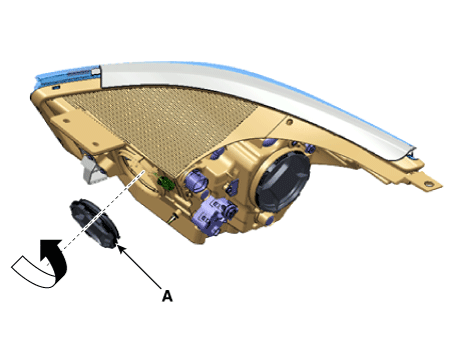Kia Niro: Lighting System / Headlamps Repair procedures
| Inspection |
| 1. |
Check the battery voltage. (Low beam will be on when the battery voltage is above 9 V.) |
| 2. |
Check the fuse and relay. |
| 3. |
Check the polarity of ballast. (The low beam will not light on in reverse polarity.) |
| 4. |
Securely connect the bulb connector. |
| 5. |
Visual bulb check (no filament): Check for damaged glass or damaged upper and lower parts of glass tube. |
| 6. |
After (1) - (5), replace the ballast and the ignitor. (ballast assembly).
|
Characteristic
| 1. |
Durable against vibration as there is no filament. |
| 2. |
HID lamp has a longer lifetime than halogen lamp. |
| 3. |
Will not operate in reverse polarity. |
| 4. |
Operating input voltage : 9 - 16 V |
| Headlamp Aiming Instructions |
| [Mechanical aiming] |
The headlamps should be aimed with the proper beam-setting equipment, and in accordance with the equipment manufacturer's instructions.
If there are any regulations pertinent to the aiming of headlamps in the area where the vehicle is to be used, adjust so as to meet those requirements. |
Alternatively, turn the adjusting gear to adjust the headlamp aiming. If beam-setting equipment is not available, proceed as follows :
| 1. |
Inflate the tires to the specified pressure and remove any loads from the vehicle except the driver, spare tire, and tools. |
| 2. |
The vehicle should be placed on a flat floor. |
| 3. |
Draw vertical lines (passing through respective headlamp centers) and a horizontal line (passing through center of headlamps) on the screen. |
| 4. |
With the headlamps and battery in normal condition, aim the headlamps so the brightest portion falls on the horizontal and vertical lines. A : Vertical B : Horizontal (1) Headlamp (Non-HLLD Type) [Halogen]
[HID]
(2) Headlamp (HLLD Type) [Halogen]
[HID]
|
Front Fog Lamp Aiming
The front fog lamps should be aimed in the same manner as the headlamp aiming.
With the front fog lamps and battery normal condition, aim the front fog lamps by turning the adjusting screw (A) with a driver.

Headlamp and Fog Lamp Aiming Point


| 1. |
Headlamp (Low beam)
[LHD]
[RHD]
|
| 2. |
Turn the front fog lamp on without the driver aboard. The cut-off line should be projected in the allowable range (shaded region)
|
Headlamp fogging
Check the below instruction procedure when the headlamps are fogged.

| Removal |
Headlamps become very hot during use; do not touch them or attach any hardware immediately after turning them off. |
|
Headlamp
| 1. |
Disconnect the negative (-) battery terminal. |
| 2. |
Remove the front bumper cover. (Refer to Body - "Front Bumper Cover") |
| 3. |
Remove the diagnosis connector (A) after loosening the mounting screw.
|
| 4. |
Remove the headlamp (A) after loosening the bolts.
|
| 5. |
Disconnect the headlamp connectors (A).
|
| Installation |
| 1. |
Install the headlamp assembly. |
| 2. |
Install the front bumper cover. |
| 3. |
Connect the negative (-) battery terminal. |
| Replacement |
Turn off the headlamp switch to avoid high voltage. |
|
Bulb (HID)
| 1. |
Remove the dust caps (A) from the headlamp assembly after turning in the counterclockwise direction.
|
| 2. |
Remove the bracket (A) after loosening the mounting screws.
|
| 3. |
Remove the ignitor lamp (A) after disconnecting the connector.
|
| 4. |
Install in the reverse order of removal.
|
Bulb (high/low)
| 1. |
Remove the dust caps (A) from the headlamp assembly after turning in the counterclockwise direction.
|
| 2. |
Disconnect the headlamp high/low beam bulb connector. |
| 3. |
Remove the headlamp high/low beam bulb (B) after removing the socket (A) from the headlamp assembly.
|
| 4. |
Install in the reverse order of removal. |
Turn Signal Lamp
| 1. |
Turn the headlamp switch off. |
| 2. |
Remove the dust caps (A) from the headlamp assembly after turning in the counterclockwise direction.
|
| 3. |
Remove the bulb socket (A) and bulb (B) from the headlamp assembly.
|
| 4. |
Install in the reverse order of removal. |
Ballast
| 1. |
Remove the headlamp. |
| 2. |
Remove the ballast (A) after loosening the screws.
|
| 3. |
Disconnect the connectors (A) from the ballast (B).
|
| 4. |
Install in the reverse order of removal.
|
 Headlamps Description and operation
Headlamps Description and operation
Description
HID Headlamp
1.
Bulb
(1)
Elements
Xenon gas: Xenon gas activates the initial reaction for rapid
illumination.
Moly ...
 Turn Signal Lamp Repair procedures
Turn Signal Lamp Repair procedures
Removal
Door Mirror Turn Signal Lamp
1.
Disconnect the negative (-) battery terminal.
2.
Remove the mirror (A) from the mirror holder ...
Other information:
Kia Niro 2017 (DE HEV) Service Manual: Front Seat Belt Buckle Repair procedures
Replacement
1.
Remove the front seat assembly.
(Refer to Front Seat - "Front Seat Assembly")
2.
Remove the front seat belt buckle (A) after loosening the mounting bolt.
Tightening torque :
39.2 - 53.9 N ...
Kia Niro 2017 (DE HEV) Service Manual: Front Door Belt Inside Weatherstrip Repair procedures
Replacement
1.
Remove the front door trim.
(Refer to Front Door - "Front Door Trim")
2.
Remove the front door belt inside weatherstrip (A).
3.
Install in the reverse order of removal.
...
























